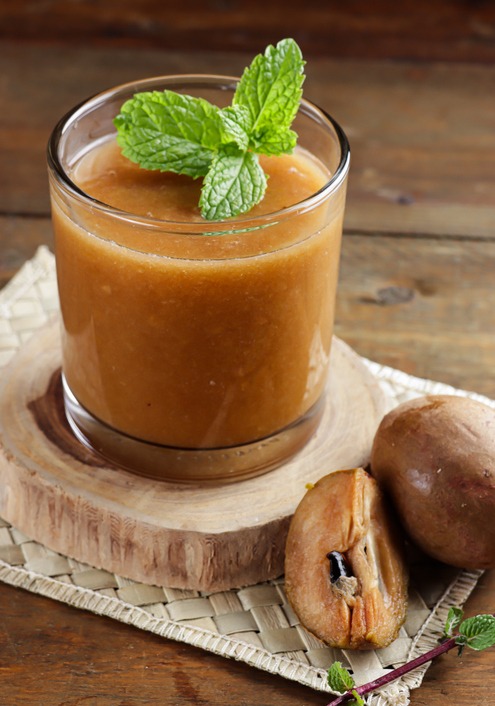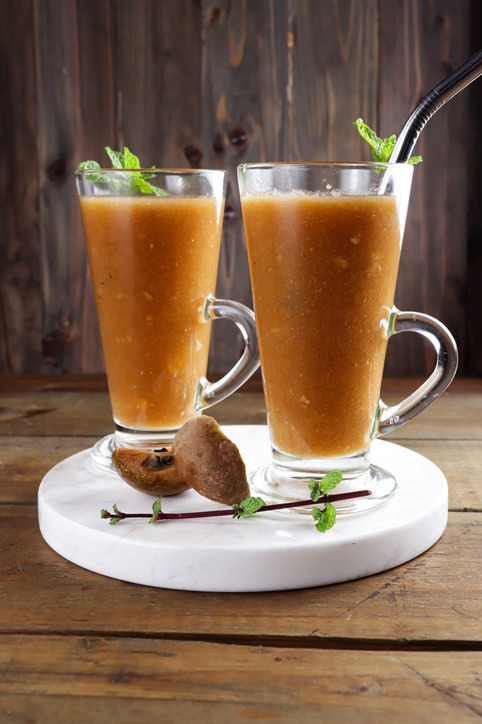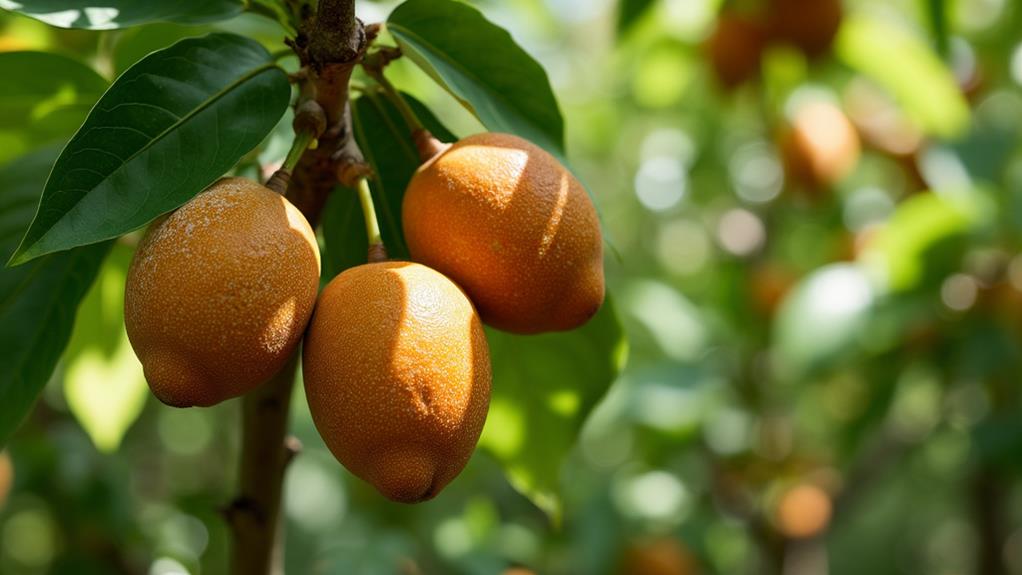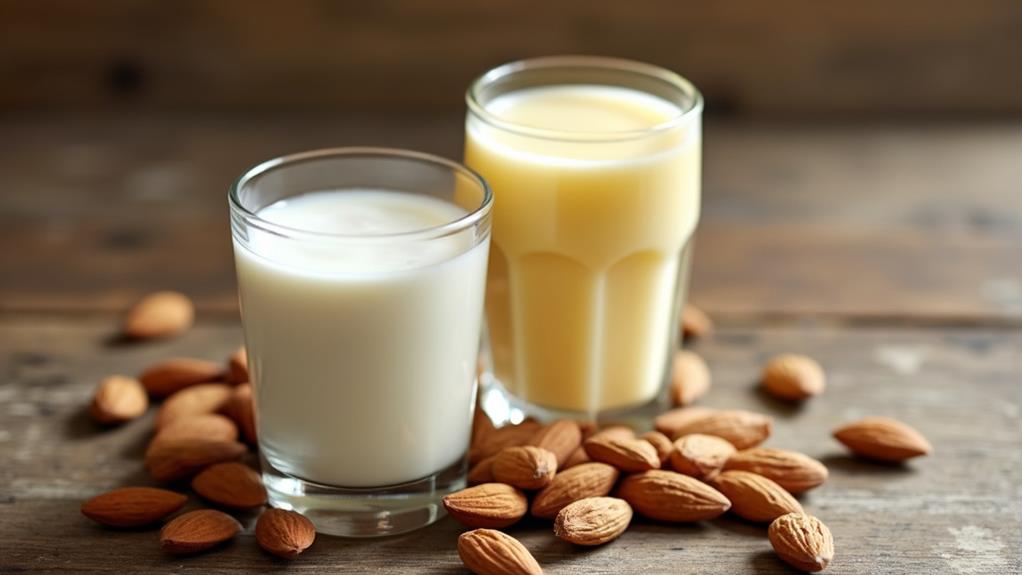Sapodilla Juice: Creamy, Sweet, and Rich in Vitamins A and C

If you're looking for a tropical delight, sapodilla juice offers a creamy and sweet experience packed with nutrition. You'll benefit from vitamins A and C, which support vision and enhance your immune system. Each serving is rich with fiber for digestive health and potassium to support your heart. The antioxidants provide anti-inflammatory advantages, enhancing general well-being. Making sapodilla juice at home is simple—just blend ripe sapodilla flesh with water, and optionally add lemon juice for an extra zing. Enjoy it as a smoothie or a revitalizing cocktail. Uncover more about this flavorful and nutritious powerhouse.
Nutritional Profile of Sapodilla Juice
When you pour yourself a glass of sapodilla juice, you're not just indulging in a sweet treat—you're nourishing your body with a powerhouse of nutrients. This delightful beverage boasts an impressive nutrition profile, making it a fantastic supplement to your diet.
Every 100 grams of sapodilla juice packs about 24.5% of your Recommended Dietary Allowance for vitamin C, vital for enhancing immune function and maintaining healthy skin. Alongside vitamin C, it contains vitamin A, important for vision health and potentially playing a role in cancer prevention. The juice's natural sugars contribute to its delicious sweetness, while providing approximately 83 calories per serving, offering you a quick energy increase without added guilt.
But the benefits don't stop there. Sapodilla juice is rich in dietary fiber, which promotes digestive health, ensuring your digestive system works smoothly and possibly aiding in blood sugar regulation. Furthermore, the juice offers about 193 mg of potassium per 100 grams, supporting healthy blood pressure levels.
Health Benefits of Sapodilla Juice
Sapodilla juice offers a multitude of health benefits that make it a valuable improvement to your diet. Packed with vitamin A, this juice supports your vision health and might reduce the risk of age-related macular degeneration. You get about 24% of your daily vitamin A needs from just 100 grams. In addition to vitamin A, sapodilla juice is an excellent source of vitamin C, providing about 28% of the daily value, essential for strengthening your immune system and aiding in wound healing.
Rich in dietary fiber, sapodilla juice aids digestion and helps regulate blood sugar levels, contributing to comprehensive digestive health. With approximately 5.3 grams of fiber per 100 grams, it's a great supplement to your diet. The antioxidants, including tannins and polyphenols, present in sapodilla juice offer anti-inflammatory benefits and protect your body against oxidative stress.
For your cardiovascular health, the juice is also loaded with potassium, providing about 193 mg per 100 grams. This mineral plays a key role in regulating blood pressure, keeping your heart healthy. Incorporating sapodilla juice into your routine can support multiple aspects of your health effectively.
How to Make Sapodilla Juice

Creating a delicious sapodilla juice at home is a straightforward process that you can easily master. Start by selecting ripe sapodilla fruits with smooth skin, as they offer the sweetest and creamiest juice. Cut each sapodilla in half and scoop out the soft, brown flesh, making certain to discard the seeds due to their potential toxicity. Gather the flesh in a blender, then add water at a 1:1 ratio for a smooth consistency. You can adjust the water to reach your preferred thickness.
To elevate the flavor and increase vitamin C content, add a splash of lemon juice. It beautifully balances the natural sweetness of the sapodilla. Once everything is combined, blend the mixture until it's smooth. For an extra silky texture, strain the blended sapodilla mix through a fine sieve or cheesecloth. This step guarantees your juice is free from any pulp remnants, resulting in a revitalizing drink.
Serve your sapodilla juice chilled, letting its creamy texture and rich vitamins A and C invigorate your senses. This homemade treat is not only delicious but also a nutritious way to enjoy the benefits of sapodilla.
Best Ways to Enjoy Sapodilla Juice
Once you've mastered making sapodilla juice, there are countless delightful ways to enjoy this creamy and sweet beverage. You can take advantage of its rich vitamins A and C, along with its antioxidant properties, to improve your daily diet. With its unique flavor reminiscent of caramel and brown sugar, sapodilla juice offers a tropical twist to diverse culinary creations.
Here are some ideas to inspire you:
- Smoothies: Blend sapodilla juice with bananas or mangoes for a delicious, nutrient-packed smoothie that supports your immune system.
- Desserts: Use sapodilla juice as a natural sweetener in puddings or custards. Its creamy texture elevates your desserts, making them irresistible.
- Ice Creams: Incorporate sapodilla juice into homemade ice creams for a tropical twist. The juice's natural sweetness improves the flavor without needing extra sugar.
- Cocktails and Mocktails: Mix sapodilla juice with your favorite spirits or sparkling water for a revitalizing drink. Its creamy flavor adds depth and richness to any beverage.
Sapodilla Juice in Global Cuisines
Indulge in the global allure of sapodilla juice, a tropical delight cherished across diverse cuisines. In tropical regions like Mexico and India, sapodilla juice captivates with its sweet, malty flavor and creamy texture. You'll find it celebrated in a variety of culinary applications, from revitalizing beverages to decadent desserts.
In Southeast Asia, sapodilla juice is a favorite addition to milkshakes and smoothies. Its rich flavor and the high content of vitamins A and C improve the nutritional profile of these drinks. By blending it with citrus fruits, you can balance its natural sweetness and create a revitalizing concoction perfect for warm climates.
Sapodilla juice is more than just a drink; it's a versatile ingredient in desserts. Imagine its rich flavor elevating ice creams and puddings, complementing other ingredients with its unique taste. Moreover, its antioxidant properties are prized in traditional medicine, supporting immune health and digestion.
Whether you're enjoying it in a tropical cocktail or a sweet treat, sapodilla juice brings a taste of the tropics to your table. Investigate its potential and savor the creamy goodness that has captured the hearts of many around the world.
Storage Tips for Sapodilla Juice
After exploring the delightful ways sapodilla juice improves global dishes, let's focus on how to keep it fresh and flavorful. Proper storage guarantees you retain its creamy texture and sweet taste while preserving essential nutrients like vitamin C. Follow these storage tips to enhance the freshness and flavor of your sapodilla juice.
- Use an Airtight Container: Store sapodilla juice in an airtight container in the refrigerator. This will help maintain its freshness, ideally consuming it within 3 to 5 days for peak taste and nutritional value.
- Add Lemon Juice: To combat oxidation and prevent browning, add a splash of lemon juice before storing. This simple step helps preserve both the lively color and the delicious flavor of sapodilla juice.
- Freeze for Longevity: If you're not planning to drink it soon, freeze sapodilla juice in ice cube trays. This method allows you to use small portions as needed while extending its shelf life.
- Avoid Sunlight and Heat: Keep sapodilla juice away from direct sunlight and heat sources, as these can degrade both its flavor and nutrient content.
Label your storage containers with the date of preparation to track freshness and guarantee safe consumption.
Sourcing Fresh Sapodilla Fruits

When seeking fresh sapodilla fruits, focus on sourcing them from tropical regions like Mexico, Central America, and India, where they're abundantly cultivated. These areas are known for producing sapodilla with the perfect balance of creamy texture and sweet flavor, rich in vitamins A and C. To find the best fresh sapodilla, you should look for fruits with smooth skin and no blemishes. This indicates ripeness and guarantees you'll enjoy the full nutritional benefits and delicious taste.
Visit specialty grocery stores and farmers markets to find these fruits, especially if you're outside the typical growing areas. Farmers markets often have fresh sapodilla directly from growers who know how to select the best produce. When buying, gently press the fruit; it should yield slightly, signaling it's ripe. Avoid any that have wrinkles or bruises, as these can mean the fruit is overripe or spoiled.
Keep in mind that while the peak season for sapodilla in places like Florida is June and July, some varieties bear fruit year-round. This means you can enjoy fresh sapodilla and its creamy goodness throughout the year, guaranteeing your juice is always packed with vitamins A and C.




